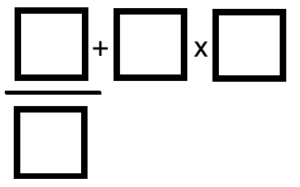**this post was elaborated on in the May 2016 issue of The Variable from the SMTS.
**this game is part of a larger collection of classroom games entitled, 16 Boxes: Ten Numeracy Routines for the Classroom available (for free) at this link.
This is a game that was adapted from a colleague in my department. He can’t quite remember where it came from, but knows there was some influence from his undergraduate days. Nonetheless, he reinvented it to play with his Grade 9s, and this post represents yet another reinvention.
The game has a simple mechanism (dice rolling), and endless extensions to elaborate on and play with. These are both keys to a great classroom game (for me anyway).
(Min + Max) imize practices basic operations within the framework of larger, conceptual decision making. While I rarely bring up the probability of the dice rolling, it is obvious that students are making decisions based on the chances of certain rolls being obtained. The idea is to practice basic skills and order of operations in a way that allows students to be active, numerate decision makers.
The game:
Each game begins with a structure. The structure is composed of a series of blanks (for the 10-sided dice rolls) and operations linking the blanks together in various ways. The students can clearly see how many rolls of the die will occur (one per blank) and copy the structure before the game begins. When all students are ready, the die is rolled. After each roll, the value must be placed in a blank. It is illegal to wait until all the rolls are complete to make choices; it is also illegal to switch a choice after it is made. (Although, when students try this, it allows me to see their thinking very clearly).
The goal:
Before each round, decide what the target should be. I usually play three rounds. In the first round, we try to maximize the result. In the second round, we try and minimize the result. In the third round, we try and get a result as close to zero as possible. Each round, the structure of the operations is altered and the die is re-rolled. After all the numbers are rolled, I circulate and collect “high scores” from students.
The boards:
Be creative with your game structures. I have had the most success with 4-5 blanks. After that, calculations can become a hindrance. As your classes get better, division and exponents are a great way to stretch their thinking. I have provided a few of the structures I use, but most are improvised in the moments of teaching in response to student’s needs.
Enjoy!
Each game begins with a structure. The structure is composed of a series of blanks (for the 10-sided dice rolls) and operations linking the blanks together in various ways. The students can clearly see how many rolls of the die will occur (one per blank) and copy the structure before the game begins. When all students are ready, the die is rolled. After each roll, the value must be placed in a blank. It is illegal to wait until all the rolls are complete to make choices; it is also illegal to switch a choice after it is made. (Although, when students try this, it allows me to see their thinking very clearly).
The goal:
Before each round, decide what the target should be. I usually play three rounds. In the first round, we try to maximize the result. In the second round, we try and minimize the result. In the third round, we try and get a result as close to zero as possible. Each round, the structure of the operations is altered and the die is re-rolled. After all the numbers are rolled, I circulate and collect “high scores” from students.
The boards:
Be creative with your game structures. I have had the most success with 4-5 blanks. After that, calculations can become a hindrance. As your classes get better, division and exponents are a great way to stretch their thinking. I have provided a few of the structures I use, but most are improvised in the moments of teaching in response to student’s needs.
Enjoy!
NatBanting




